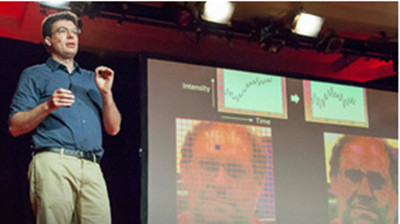So here's the sound that we played in the room.
這是我們在房間中播放的聲音。
And this is a high-speed video we recorded of that bag of chips.
這是我們攝制的薯片袋的高速視頻。
Again it's playing.
同樣,
There's no chance you'll be able to see anything going on in that video just by looking at it,but here's the sound we were able to recover just by analyzing the tiny motions in that video.
您憑肉眼是看不出來什么的,但是我們可以通過分析視頻中微小的振動恢復出原有的聲音。
I call it Thank you.
我叫它-謝謝。

I call it the visual microphone.
我叫它視覺麥克風。
We actually extract audio signals from video signals.
實際上我們從視頻信號中提取了音頻信號。
And just to give you a sense of the scale of the motions here,a pretty loud sound will cause that bag of chips to move less than a micrometer.
為了讓您了解運動的大小,一個特別大的聲音可以導致薯片袋一微米的變化。
That's one thousandth of a millimeter.
也就是千分之一毫米。
That's how tiny the motions are that we are now able to pull out just by observing how light bounces off objects and gets recorded by our cameras.
這就是我們能夠提取出來的微小運動僅僅是通過攝像機錄制的視頻觀察光線在物體上的變化。
We can recover sounds from other objects, like plants.
我們可以從物體上重構出原聲音,如植物。
And we can recover speech as well.
我們也可以重構出講話。
So here's a person speaking in a room.
這是一個人在房間中講話。
Michael Rubinstein: And here's that speech again recovered just from this video of that same bag of chips.
邁克爾魯賓斯坦:這是一個講話這段視頻同樣是由那個薯片袋重構出聲音。
We used Mary Had a Little Lamb because those are said to be the first words,that Thomas Edison spoke into his phonograph in 1877.
我們用兒歌Mary Had a Little Lamb因為托馬斯愛迪生在1877年,第一次錄制在留聲機上的也是這首兒歌。
It was one of the first sound recording devices in history.
這是歷史上第一個錄音設備。
It basically directed the sounds onto a diaphragm that vibrated a needle that essentially engraved the sound on tinfoil.
原理是把聲音錄在薄膜上聲音通過振動的針頭刻錄在錫箔上,
that was wrapped around the cylinder.
錫箔被包裹在圓柱體上。
Here's a demonstration of recording and replaying sound with Edison's phonograph.
這是演示愛迪生留聲機的錄制和回放。
And now, 137 years later,we're able to get sound in pretty much similar quality but by just watching objects vibrate to sound with cameras,and we can even do that when the camera is 15 feet away from the object, behind soundproof glass.
137年過去了,我們可以重構出同樣質量的聲音卻是通過觀察攝像機拍攝的物體振動實現的,我們甚至可以把攝像機放到15英尺外隔音玻璃后邊。
So this is the sound that we were able to recover in that case.
這是我們在這種情況下還原的聲音。
And of course, surveillance is the first application that comes to mind.
當然,監控是我們想到的第一個應用。
But it might actually be useful for other things as well.
但是它應該還有其他用處。
Maybe in the future, we'll be able to use it, for example,to recover sound across space,because sound can't travel in space, but light can.
可能,未來我們可以用它太空中還原聲音,因為聲音不可以在太空中傳播,但光可以。
We've only just begun exploring other possible uses for this new technology.
我們僅僅是剛剛開始探索這項新技術的可能用途。
It lets us see physical processes that we know are there,but that we've never been able to see with our own eyes until now.
這讓我們熟知的物理過程,變得肉眼可見了。
This is our team.
這是我們的團隊。
Everything I showed you today is a result of a collaboration with this great group of people you see here,and I encourage you and welcome you to check out our website,try it out yourself,and join us in exploring this world of tiny motions.
今天我展示的一切,都是這群偉大的人的協作成果。我鼓勵您,歡迎您訪問我們的網站,親身體驗,加入我們,一同探索微小振動的世界。
Thank you.
謝謝。











